NYC News
Le Veau d’Or Makes A Triumphant Return on the Upper East Side
August 8, 2024, 8:12.04 pm ET
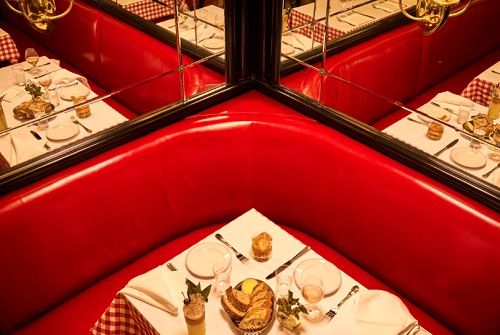
Photos: Gentl + Hyers
Since its opening in 1937, Le Veau d’Or has been a favorite of Upper East Siders and celebrities alike. Orson Welles had the window banquette. Grace Kelly met Oleg Cassini here. James Beard, Jacqueline Onassis and Marlene Dietrich had house accounts.

Original Reservation Book
Owned by just three families in its 87-year history, the intimate restaurant has continuously served what New Yorker with bistro classics, many now forgotten, made famous by the legendary Henri Soulé’s French pavilion at the 1939 World’s Fair.
Regulars would return for the saucisson chaud in brioche, the tripes à la mode de Caen and poussin en cocotte grand’mère, cooked with Champagne, among other bourgeois favorites — dishes that earned the restaurant four stars from Craig Claiborne in 1968.
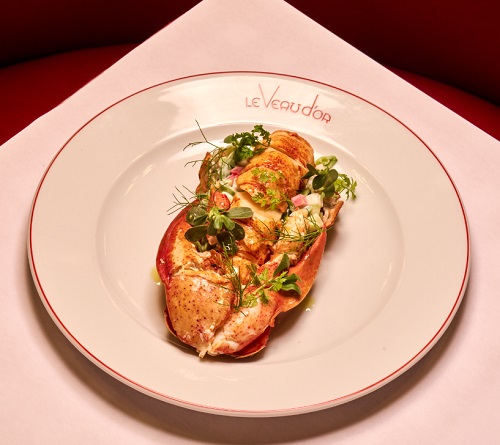
It was the combination of “The Veau’s” confident cooking, unstuffy ethos and untouched room, with its wood paneling and black-and-red linoleum floors, that attracted Lee Hanson and Riad Nasr, founders of Frenchette, to the idea of someday becoming its future owners.
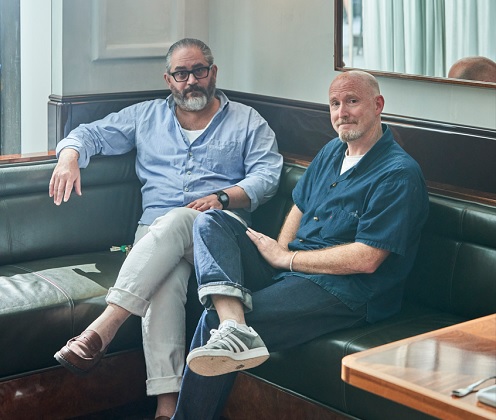
Riad Nasr and Lee Hanson (Left to Right)
The chefs met while cooking at Daniel in the 1990s before making names for themselves at Balthazar and Minetta Tavern. Beginning in 2012, they would call Cathy Treboux, the daughter of the third owner, Robert — who had worked at Le Pavillon under Soulé — every few years to ask if she would ever consider selling.
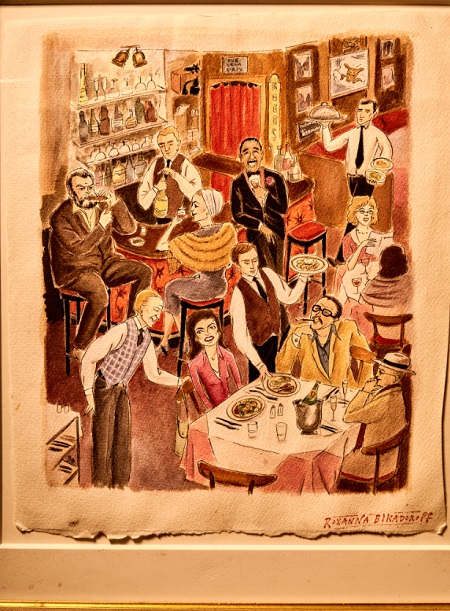
“It’s so historic that we always thought the city should have come in here and preserved it,” says Hanson. “The other le’s and la’s in the area have gone.”
In 2019, Treboux finally said yes. In the interim came Covid and the opening of the duo’s second restaurant, the Rockefeller Center brasserie Le Rock, followed by Frenchette Bakery at the Whitney.
With the reopening of Le Veau d’Or, the longtime Upper East Side regulars who called it home for decades, have watched closely as this French treasure was lovingly restored.
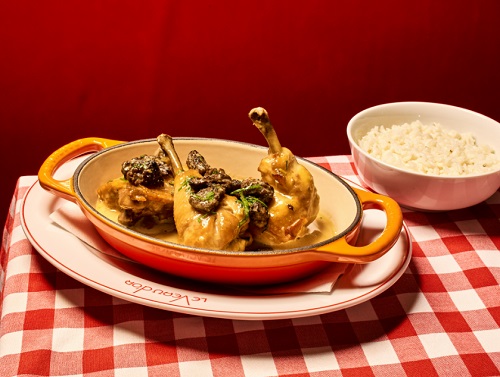
Photos: Gentl + Hyers
“There’s a lot of foundation here,” said Nasr of the menu. “We started with the original menus and began cooking those dishes in an authentic way but with a little modern sensibility. It’s not fussy food. We wanted a place where you think you have a notion of what your perfect meal here is before you walk in.”
Overseen by longtime collaborators, chefs Jeff Teller and Charles Eizenstein, who have cooked with Hanson and Nasr since Minetta Tavern, the menu remains a prix fixe, offering the choice of 10 appetizers, 10 entrées and 5 desserts.
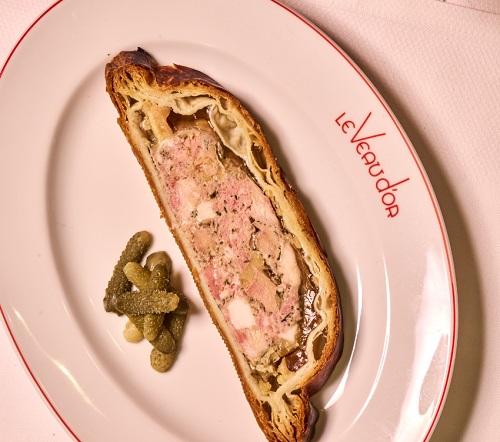
Appetizers include pommes soufflés caviar rouge à la crème, pâté en croute and frogs’ legs persillade. Entrées range from duck magret with cherry sauce to a daily fricassé poulet avec vin jaune to onglet frites served au poivre or with sauce béarnaise. (The restaurant’s traditional calf’s head has evolved into tête de veau ravigote.) Cheese are also being offered before dessert.
Pastry chef Michelle Palazzo takes her inspiration from traditional French desserts, such as île flottante, gratin de chocolat, strawberries with sabayon, and composed coupes glacées that will change seasonally.
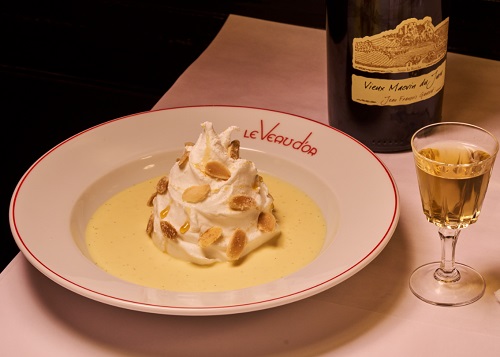
At the original Le Veau d’Or, there was no wine list: diners could choose either red or white. (Red meant Châteauneuf du Pape and Bordeaux.) James Beard-nominated Wine director Jorge Riera, a longtime Hanson/Nasr collaborator, has developed a 100-bottle list highlighting France, with a seasonal selection of Champagnes. As with Frenchette and Le Rock, Riera celebrates small farmers who produce natural wines by hand from vineyard to bottle. Because Riera makes a point of visiting the winemakers to forge a personal connection, he is able to serve bottles that rarely leave France.
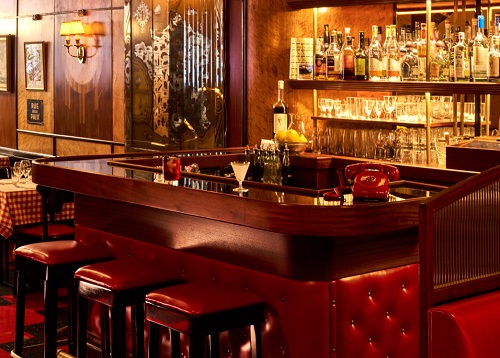
The four-seat bar area offers classic cocktails, as well as the original Le Veau d’Or apéritif and Le Veau d’Or cocktail, a rousing mix of Dubonnet, kirsch and lemon juice. Beverage director Sarah Morrissey has also developed 8 playful shooters that play on French and American drinks, such as a shot version of the traditional trou Normand — a glass of Calvados drunk between rich courses — incorporating sorbet.

The casual intimacy and original details of the space have been restored or reproduced — from the inlaid wood paneling to the red-and-black linoleum and the red leather chairs and banquettes — as well as much of the signature artwork, including the sleeping calf (a play on “le veau dort,” a homonym of Le Veau d’Or.) The upstairs, once Cathy Treboux’s office, is home to an elegant, 20-seat private dining room and bar.

Also continuing the lineage: Treboux’s son, Derek Summerlin, is the opening maître d’, keeping the family’s legendary hospitality alive for a new generation of regulars. While initially open only for dinner service from Tuesday to Saturday from 5-10 p.m., Le Veau d’Or will be open for lunch Tuesday to Saturday beginning in mid-September. Reservations can be made online at https://www.lvdnyc.com and are also available via Resy. Walk-ins are welcome.
LATEST NYC NEWS

Love at First Bite at Gui Steakhouse in the Theater District
March 13, 2025, 6:39 pm ET
The Theater District is fast-becoming a destination, thanks to restaurants like Gui Steakhouse, a bi-level space with an attractive bar on the ground level, called Bar 92, and a stunning jewel-toned... READ MORE

Figaro Café Reboots with a New Executive Chef
March 13, 2025, 5:05 pm ET
In the heart of Greenwich Village, where literary legends, jazz artists and poets once roamed, Figaro Café (184 Bleecker St) is turning over a new leaf. Under the watchful eye of General Man... READ MORE
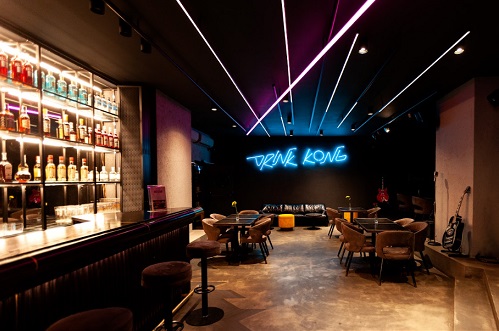
Rome Meets New York as Drink Kong Takes Over Aqua Spirit
March 13, 2025, 3:38 pm ET
On Tuesday, March 25, Flatiron’s Aqua New York is hosting an exclusive bar takeover of Aqua Spirit, welcoming Rome’s acclaimed Drink Kong—one of the World’s 50 Best Bars&mdas... READ MORE


 Sign up for our newsletter !
Sign up for our newsletter !